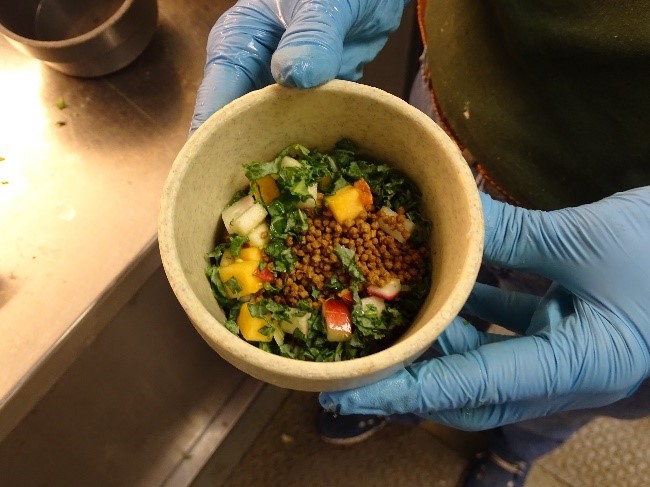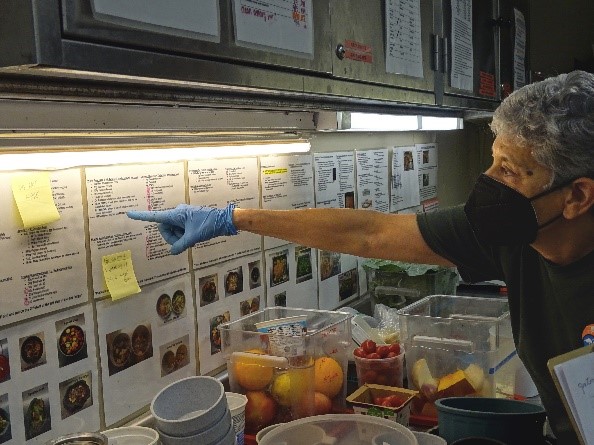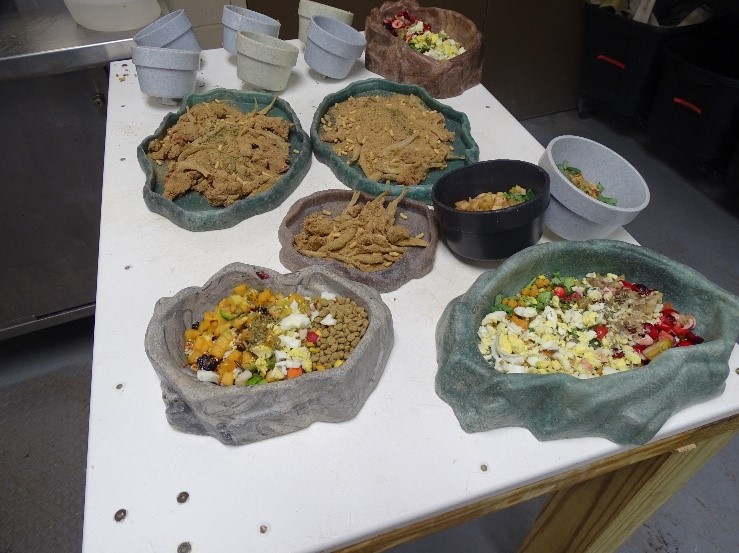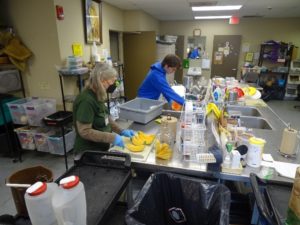Not your Mother’s Kitchen
December 9, 2022
The two kitchens at the zoo have some things in common with your mother’s kitchen: refrigerator, freezer, microwave, sink, fruits, and vegetables. However, they have many differences: over 110 animal diets, frozen mice, cans of dog food, 50-pound bags of various pellets, and mealworms.
Enough to feed an army
The larger of Miller Park Zoo’s two kitchens is in the Katthoefer building and a smaller one in the Zoolab building. Each day, the diets for over a thousand animals, including insects, reptiles, and birds, are prepared by keepers and volunteers in one of these kitchens.
While your mother no doubt appreciated a break from preparing meals when the family went out to eat there are no breaks at the zoo. No matter the weather meals must be prepared and delivered every single day. When weather threatens keepers stay closer to the zoo with friends so they can get to the zoo no matter what.
Catering to "unique" palates
The complexity of diets varies from the one ingredient diets of crickets for a frog to an up to 10-ingredient diet for a slow loris (a small Asian primate). And, yes, some animals do get peanut butter sandwiches. Langurs get their peanut butter sandwich with a banana slice in the center. The diet for a specific animal may have been determined by an animal nutritionist responsible

for creating and creating and balancing rations to ensure all dietary needs are met for specific animals.
When a new animal arrives at the zoo the diet it consumed at the previous zoo is considered, as well as what was fed to the species if they have been held at the zoo before. The veterinarians also provide diet advice based on medical needs of specific animals.
Most animals are fed twice a day. Feeding times can vary. The cats are fed around 4:30 PM. A few animals are not fed every day. The reticulated python snake, for example, is fed once every six weeks. Some animals are fed different amounts depending on the time of year. The alligator is fed less in winter because their metabolism is slower when the temperature drops. This dormancy is not hibernation, but scientists refer to it as brumation.
Next time you are at the store and you notice a person with a cart overflowing with produce you may be looking at a zoo volunteer shopping for a weeks-worth of animal meals. If you happen to stop at the pharmacy you may be standing next to a volunteer picking up medicine needed for an animal diet. In additional to produce from local grocery stores AB Hatchery delivers pellets, grains, seeds and "primate chow" biscuits.
FUN FACT: Miller Park Zoo is home to over 1000 individuals (not counting 2000+ honeybees) from 144 species.
Volunteer chefs
It takes a lot of time and people to prepare all the meals needed for just one day. Keepers and volunteers handle the preparation.

Every Friday from 8:00 AM till noon and every other Sunday Marcia Hammerstrand can be found chopping and weighing ingredients as she prepared meals for the animals. For over 25 years Marcia has volunteered at the Zoo. In recent years her time has been spent preparing meals. Watching her weigh out 5 grams of water for the Tree Shrew diet shows how precise the recipes are.
Keepers distribute the meals in several ways. Food for the tiger is placed throughout his enclosure so he has to hunt around to find it. Some meals are delivered in rock-like bowls. When more than one animal is fed in the same enclosure keepers use various techniques to ensure each animal gets its food. For the primates keepers set up separate feeding stations and puzzle feeders that take time for the animal to get to the food.
Keepers distribute the meals in several ways. Food for the tiger is placed throughout his enclosure so he has to hunt around to find it. Some meals are delivered in rock-like bowls.
When more than one animal is fed in the same enclosure keepers use various techniques to ensure each animal gets its food. For the primates keepers set up separate feeding stations and puzzle feeders that take time for the animal to get to the food.

Meal preparation goes on behind the scene. Guests may see the animals consuming their food but do not see the keepers and volunteers chopping, weighing, heating, mixing, and distributing meals every day. This is just one example of the work that goes into providing excellent care for the residents of our zoo.
Are you interested in volunteer opportunities at Miller Park Zoo? Learn more at their website using the link below.




